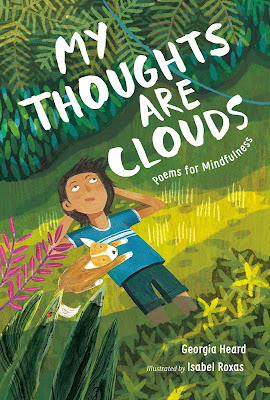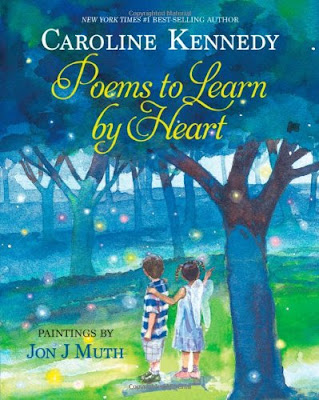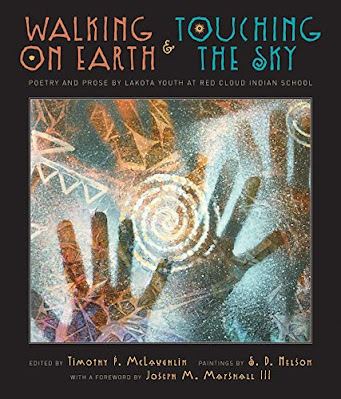They Call Me Güero: A Border Kid’s Poems
Bibliography:
Bowles, David. They Call Me Güero: A Border Kid’s Poems. El Paso: Cinco Puntos Press, 2018. ISBN: 978-1947627079.
Summary:
They Call Me Güero is a portrait of life in the Rio Grande valley of Texas, told from the perspective of a young Mexican-American middle schooler known affectionately as Güero. The poems document childhood memories of growing up on both sides of the border, celebrating holidays with family traditions, weddings, quinceañeras, basketball games, cookouts with carne asada, folktales retold by tios and abuelas, making tamales at Christmas, getting bullied at school for being too white-skinned, texting, gaming, making friends with Los Bobbys, and feeling pride in his own culture and identity. The text is filled with Spanish phrases, and a glossary at the end of the book translates dozens of common words and expressions.
Analysis:
The poems in They Call Me Güero create a diverse mural of Latinx identity, demonstrating the complexity and differences within the community. The poems celebrate cultural traditions while resisting stereotypes. Güero’s three best friends, Los Bobbys, are their own microcosm of diversity. “See, I hang with an unusual crowd. / Bobby Handy, the half-white Chicano; / Bobby Lee, whose parents are from Seoul; / and Bobby Delgado, dominicano moreno.” El Güero y los Bobbys are academic types interested in comics, gaming, and books. El Güero himself, at the advice of his abuela, learned to read at a young age and enthusiastically devoured library books, reading at a level far ahead of his classmates. Still, when his family crosses a checkpoint on the way to San Antonio, they are treated with suspicion. “A cold nod and we’re waved along, / allowed to leave the borderlands- / made a limbo by the uncaring laws / of people a long way away who don’t know us, / a quarantine zone between white and brown. / I feel angry, just like my sister, / but I hold it tight inside.” David Bowles uses the metaphors of “limbo” and “quarantine zone” to highlight the uncertain state that exists around the border for people of Latin origin, even if they are American citizens. Güero’s uncle Joe gives him history lessons, the stuff they don’t teach you in school. He tells Güero how he told his school counselor that he wanted to be a lawyer, but “That white lady almost / laughed in my face,” suggesting instead that he go to technical school and become a mechanic. He tells Güero how his paper about the Conquista was rejected for being too good, the racist teacher assuming it was plagiarized. Throughout the book, Bowles confronts racism and discrimination, yet there is a sense of pride and dignity that readers of any culture will recognize and appreciate.
Folktales play a strong role in the poems. El Cucuy, the Latin American boogeyman, appears in a lullaby sung by Güero’s abuela, a figure meant to warn children to be good. Güero takes this lesson from the song: “So I learned the dangers / of this crazy, mixed-up place-- / there are monsters lurking, / but family lore can keep you safe.” This recurring theme that family and tradition serve as a protection continues throughout the book. Güero’s English teacher, Ms. Wong, draws connections between Korean and Mexican culture, teaching that both believed “the marks on the moon / are in the shape of a rabbit, placed there by the gods.” She teams up with the social studies teacher to guide students in a study of traditional masks that “can either hide or reveal your identity.” Güero realizes that his animal soul is “The Feathered Coyote. / Aztec Trickster. God of music and mischief, / wisdom and story-telling. All decked out / with orange and gold feathers / to echo my own copper hair.” As Güero gets older, his literal understanding of these folk stories takes on new depth as he begins to grasp their metaphorical power.
The Spanish language, in all its diversity, is central to David Bowles’s poetry. Nearly every poem contains some words written in Spanish, and bilingual readers will recognize common slang and dichos used by the characters. In the poem, “Spanish Birds,” Bowles uses simile and metaphor to describe the different styles of Spanish that exist all around him. “Everyone I know / speaks a different Spanish: / The rural twang of border folk, / the big-city patter of immigrants, / the shifting mix of Tex-Mex. [...] Mom’s Spanish flits around / like a hummingbird- / a fast and frantic blur of color / delicate dancing perfection. / Dad’s is like a swan- / ugly and awkward at first, / but growing into something beautiful, / comfortable in both water and air. / Delgado’s Dominican accent / reminds me of flamingos- stepping high to avoid every ‘s,’ / beaks making each ‘r’ liquid.” Güero completes the metaphor with a beautiful description of his own Spanish: “I hear the echo of their calls / when I speak. / My own tongue / is an aviary.” This gorgeous image encapsulates Güero’s mind; he is the convergence of everyone he knows and loves, their identities combining in him like tributaries to a river. Readers of all cultures will connect with the universal experiences of Güero’s life, while deepening their understanding of Latinx cultures and traditions. It is no surprise that They Call Me Güero is the winner of more than a dozen awards and recognitions. Highly recommended for grades 6 and up.
Excerpt:
“Wheels”
Tío Dan loves his lowrider--
candy apple red and mint green,
thirteen-inch whitewalls, wire-spoke rims,
it dominates at car shows.
Uncle Joe drives his pickup truck
all over his ranch, hauling hay
and fenceposts and sometimes a calf.
He can’t work without it.
Mom prefers her compact sedan,
great gas mileage, low emissions,
just enough room for her three kids--
our dad can squeeze in too.
Mimi has her black Oldsmobile.
“Like a hearse,” she morbidly jokes.
it’s ancient, yes, but with a few miles--
to church and back, that’s all.
Their wheels all fit them to a tee…
I wonder what my car will be.
My sister laughs, “You’re such a nerd--
you’ll go for a hybrid!”
Activity:
Introduce the poem “Wheels,” and ask middle-grade students to think about what the descriptions reveal about each character in the poem.
Ask them to think about the people in their families and what cars they drive.
Invite them to share what cars they think best represent themselves. Encourage them to think metaphorically and connect the car’s style and function to their attitudes, styles, and dispositions.
Invite students to print, draw, or cut out magazine pictures of cars and write poems about the cars that reflect their own personalities.




Comments
Post a Comment